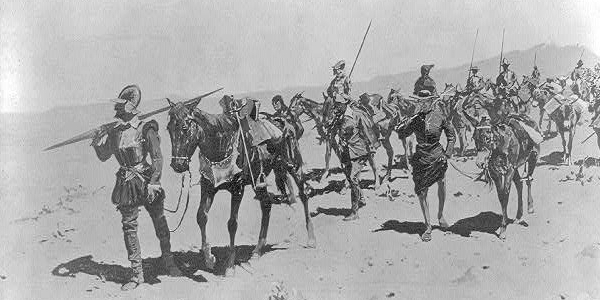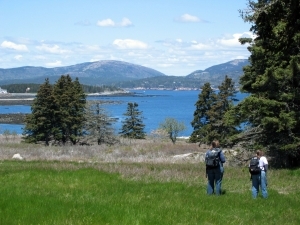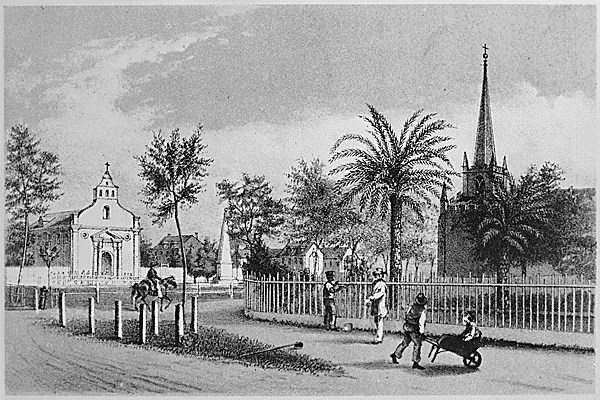Sponsor this page. Your banner or text ad can fill the space above.
Click here to Sponsor the page and how to reserve your ad.
-
Timeline
Detail - 1559
September 19, 1559 - Pensacola colony devastated by hurricane, eventually forcing a move inland to an abandoned Indian village named Nanipacana, which they renamed Santa Cruz de Nanipacana. The colony was abandoned altogether in August 1561.

With the hurricane devastating the colony at their intended location at Pensacola Bay just weeks after their arrival (there are some sources that list this as days, August 15), costing the settlement all but three ships and most of their supplies, Tristán de Luna sent an expedition party of two hundred soldiers, on September 24, 1559, to search for an inland town where supplies, and perhaps a move, could be enacted. They found Nanipacana, an Indian town of eighty dwellings, mostly abandoned. After spending most of the winter at the port, de Luna finally decided that the entire colony, except a small detachment of soldiers, would move there. He would call it Santa Cruz de Nanipacana. The remainder of the fifteen hundred colonists were sent, by land and boat, toward their destination in mid-February 1560.
It was not long before the new colony at Nanipacana was in difficult straits. Two supply ships had arrived from New Spain in November, but those supplies had not lasted long. The natives in the area were unwilling to assist with trade, thus cutting off another option. A party of men who had been with de Soto, some Indian women, and two hundred soldiers, decided to search for Coosa, leaving Nanipacana on April 15, 1560. The party advanced for nearly two months before reaching the first towns of Coosa in today's northwest Georgia, finding little food along the way, but sending some back to Nanipacana. The natives of Coosa, supplied four bushels of corn per day, but that was insufficient for those beyond the contingent there.
By the end of July, Tristán de Luna and the remining colonists were in desperate shape. Supply ships from Vera Cruz that had been dispached on June 23 had not arrived. Another plan to drive five hundred cattle from Mexico to Florida overland had been abandoned. The colonists were growing restless, petitioning de Luna to send them back to New Spain; he refused, agreeing to send their concerns back to the Viceroy in fifty days if the situation did not improve. When word finally arrived about the situation at Coosa, de Luna proposed that those who wished could go there. That did not satisfy them. Finally, on June 22, de Luna agreed that the colony at Nanipacana should be deserted and move to Mobile Bay (Bajía Filipina), awaiting the relief ships from New Spain. Nanipacana was abandoned on June 24, 1560.

The Colony Disbands in 1561
On June 24, 1560, the remaining colonists at Santa Maria de Nanipacana deserted the town, leaving a note for the soldiers on the expedition to Coosa where they were heading. When a small contingent from Coosa arrived with news of their findings, they joined the contingent at Bajía Filipina. Eight days after the colonists arrived at Mobile Bay, the supply ship from New Spain arrived, but without enough food to sustain them. Women and children were boarded on the supply ship and returned to Vera Cruz so that the supplies that was left could sustain the soldiers. Orders also arrived on the supply ships, all the way from the King, to Tristán de Luna, the fated governor of what would soon become the former Pensacola colony, that the project in South Carolina, Santa Elena, was now to have preference due to fear of a French settlement, and that he should assist them. All this while his own was starving. Tristán de Luna dispatched one ship, with two more that had arrived from Vera Cruz, to South Carolina on August 10, 1560, to found a temporary settlement there. They never arrived, caught in a storm near La Havana.
As the year progressed, the party at Mobile Bay once again moved back to Ochuse (Pensacola) with mutiny in the wind and Tristán de Luna ill. There were three hundred and sixty-two in the port of Pensacola in the fall of 1560; the majority of the two hundred soldiers at Coosa remained there, thirty were on a ship, the San Juan headed back from Cuba, and many married men and women had been sent back to New Spain. By 1561, de Luna was asking for his own removal; it was agreed to with the announcement of a new governor for the Ochuse colony, Angel de Villafañe. Villafañe's orders were to arrive in Ochuse (April 1561), leave a small detachment there, take the remainder to La Havana for resupply before going again to Santa Elena to colonize there. Tristán de Luna arrived back in Madrid, Spain on August 20, 1561.
For the colony at Pensacola, Ochuse, it was in its last months. Fifty men under Captain Biedma remained there until August 1561, ordered to occupy the colony by Villafañe as he awaited further orders from the Viceroy of New Spain. Without orders to remain there, Villafañe picked up the remaining men that August and returned them to Vera Cruz. While the colony at Pensacola had failed, it had been the first multi-year settlement, 1559-1561, in the Continental United States. The first permanent colony in Florida would not be established until four years later, in 1565, by the Spanish at St. Augustine. Pensacola would not be recolonized by Europeans again until 1698.

Image above: Montage (left) Statue of Tristán de Luna, 2009, Carol M. Highsmith. Courtesy Library of Congress; (right) Lithograph of Pensacola, 1885. Courtesy Library of Congress via Wikipedia Commons. Photo below: A View of Pensacola, 177)'s, George Gauld. Courtesy Library of Congress. Source info: "The Luna Papers 1559-1561," 1928, H.I. Priestley, The Florida State Historical Society; "The Discovery and Exploration of Tristán de Luna y Arellano's 1559-1561 Settlement on Pensacola Bay," 2020, John E. Worth, Elizabeth D. Benchley, Janet R. Lloyd, Jennifer A Melcher; floridahistory.com; "UWF archaeology program discovers third shipwreck from Luna fleet," 2016, University of West Florida; de-luna.com; Wikipedia.





